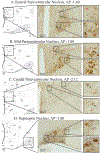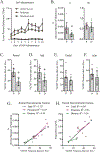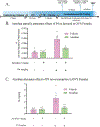Oxytocin attenuates demand for cocaine in female rats
- PMID: 40678445
- PMCID: PMC12269613
- DOI: 10.1016/j.addicn.2025.100197
Oxytocin attenuates demand for cocaine in female rats
Abstract
There are substantial sex differences in substance use disorders (SUDs), and a key feature of SUD is pathologically high economic demand for drug. The hypothalamic neuropeptide oxytocin (OXT) is heavily implicated in the modern treatment of SUDs. Using a within-session threshold behavioral economics (BE) procedure, we quantified demand elasticity (a, inverse motivation) and free consumption (Q0) in male and female rats to investigate the effect of OXT on cocaine demand. Results showed that OXT decreased motivation for cocaine; an effect greater during the high-demand phase (diestrus, low progesterone, P4) vs low demand phases (proestrus, high P4). We confirmed our prior findings that P4 attenuates cocaine demand in female rats and that chronic cocaine self-administration disrupts estrus cyclicity. Following each injection, OXT at either 0.1mg/kg or 0.3mg/kg restored estrous cycling in intact females with prior cocaine experience for one week and remained effective with up to 4 weeks of injections. Fos reactivity in OXT+ neurons was greater when rats were in proestrus compared to diestrus and significantly correlated to motivation and circulating levels of P4. Finally, using ovariectomized females with P4 replacement, we show that P4's demand attenuating effects are reversed by atosiban (1.0 mg/kg, IP), an OXT antagonist. These data show an interaction between oxytocin and progesterone in female rats that may underlie differences in cocaine demand between sexes. Additionally, we show critical periods for using OXT as a treatment to reduce cocaine demand in females. Our results indicate novel therapeutic treatments for SUDs must be tailored to hormonal states.
Keywords: Behavioral economics; Cocaine; Oxytocin; Progesterone; Sex differences.
Conflict of interest statement
Declaration of competing interest The authors declare that they have no known competing financial interests or personal relationships that could have appeared to influence the work reported in this paper.
Figures




Similar articles
-
Oxytocin Attenuates the Endocrine Disrupting Effects of Cocaine in the Female Rat.Endocrinology. 2025 May 19;166(7):bqaf096. doi: 10.1210/endocr/bqaf096. Endocrinology. 2025. PMID: 40404291
-
The Black Book of Psychotropic Dosing and Monitoring.Psychopharmacol Bull. 2024 Jul 8;54(3):8-59. Psychopharmacol Bull. 2024. PMID: 38993656 Free PMC article. Review.
-
Interventions for preventing weight gain after smoking cessation.Cochrane Database Syst Rev. 2012 Jan 18;1:CD006219. doi: 10.1002/14651858.CD006219.pub3. Cochrane Database Syst Rev. 2012. Update in: Cochrane Database Syst Rev. 2021 Oct 6;10:CD006219. doi: 10.1002/14651858.CD006219.pub4. PMID: 22258966 Updated.
-
Sertindole for schizophrenia.Cochrane Database Syst Rev. 2005 Jul 20;2005(3):CD001715. doi: 10.1002/14651858.CD001715.pub2. Cochrane Database Syst Rev. 2005. PMID: 16034864 Free PMC article.
-
Discontinuation of intravenous oxytocin in the active phase of induced labour.Cochrane Database Syst Rev. 2018 Aug 20;8(8):CD012274. doi: 10.1002/14651858.CD012274.pub2. Cochrane Database Syst Rev. 2018. PMID: 30125998 Free PMC article.
References
-
- Sinha R, Catapano D, O’Malley S, Stress-induced craving and stress response in cocaine dependent individuals, Psychopharmacology 142 (1999) 343–351 (Berl.). - PubMed
-
- Brady KT, Sinha R, Co-occurring mental and substance use disorders: the neurobiological effects of chronic stress, Am. J. Psychiat 162 (2005) 1483–1493. - PubMed
-
- Sinha R, Fuse T, Aubin LR, O’Malley SS, Psychological stress, drug-related cues and cocaine craving, Psychopharmacology 152 (2000) 140–148 (Berl.). - PubMed
-
- McCance-Katz EF, Carroll KM, Rounsaville BJ, Gender differences in treatment-seeking cocaine abusers - Implications for treatment and prognosis, Am. J. Addict. 8 (1999) 300–311. - PubMed
Grants and funding
LinkOut - more resources
Full Text Sources
